Even Stranger on the Shore – The tale of a supermarket on a beach
Making TV commercials is rarely totally straightforward. Here’s the story of one production from 2011 which might serve as a warning that even the most complicated productions can always get worse.
The project DDB London was faced with was always going to be tricky. A woman starts to speak to camera in a supermarket. As she walks and talks to us about her life and what she wants from it, her environment changes and now she’s on a beautiful beach. Still speaking directly to us she briefly enters a forest where she encounters her son playing and cuddles him.
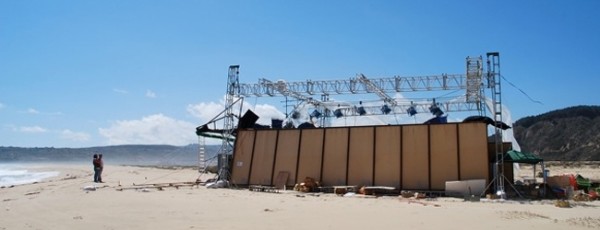
From the forest she seamlessly walks onto a mountaintop 10,000 feet high in the Andes. Appreciating the view and still speaking to us she joins her husband in a hot air balloon which, after a brief trip, deposits her on an urban terrace in the middle of a city where she greets old friends, before joining her family on a bicycle ride, still speaking to us.
Hopping off the bike she enters a living room, ages 15 years and encounters her future grandchild before walking directly back into the supermarket she started in, losing the 15 years and continuing to deliver the advertiser’s message. As I said, it was never going to be easy.
Now add the complication that it needs to be shot six times with five different women – British and Canadian accents, Belgian and Canadian French, Dutch and German – plus a mute version for the languages you haven’t yet thought of. Since the spot needs to be delivered in several different time lengths, each shot is going to need to be tailored with different in-points and out-points so that the 30-second version works as smoothly as the 60-second, and of course some markets want a 40-second and a 20-second, plus a couple of 10-seconds. Could it get any more difficult?
Now add the complication that it needs to be shot six times with five different women in English.
Since the films needed to be seamless from beginning to end we needed to think about how we could possibly shoot it. In the end we arrived at a solution that mixed ‘real’ transitions with hidden edit points and places where we could cheat a little. So the transition from supermarket to beach would be real, as would the transition into the beginning of the forest. An edit could be hidden behind a foreground tree so the next scene could be linked through to the mountaintop, the edit hidden behind another branch.
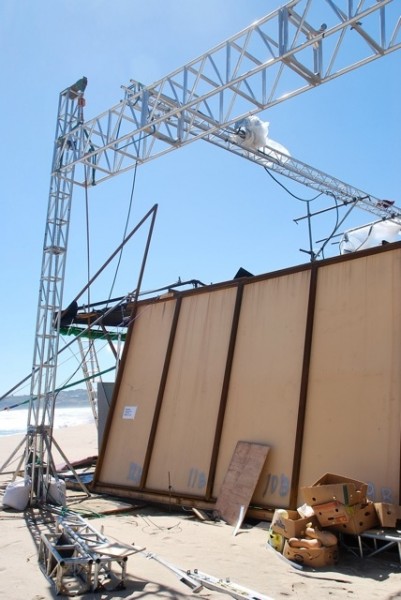
The hot air balloon would be genuinely rigged up in the mountains. This would allow a real background to be used and an edit hidden away in the transition to the urban terrace, which would be built with a green screen background to allow different cityscapes to be inserted in post-production tailored to the market that film was to run in. Are you following? I’m sure you’re lost by now but I think you get the idea – complicated.
Where could we possibly shoot with our location list of beaches and mountains, countryside and European/Canadian domestic architecture? We had to shoot in March so the northern hemisphere was essentially ruled out. We looked briefly at New Zealand and Australia – a little too far to go and somewhat on the expensive side. South Africa was a strong possibility but with the scenic flats and art department builds we were worried about the effects of wind.
South America was looked at too and Chile started to emerge as the best candidate. Decent weather, less wind than South Africa, a good source of local casting in Santiago and Buenos Aires, and all the locations on our list.
So we found ourselves flying down to Santiago, Pre-Production Meeting negotiated, storyboard agreed, an 11-day shooting schedule planned, locations sorted and casting almost complete. Apart from the key featured artistes who we cast in Canada, the UK, Holland, Belgium and Germany, all the other non-speaking parts were to be sourced in South America, being careful to try to make the ‘family members’ as physically similar to our principals as possible.
Wardrobe was also a Chilean responsibility although it quickly became obvious that our thoughts on what would be appropriate dress for shopping in a supermarket and walking on the beach were somewhat different from the local take. After a couple of additional wardrobe sessions and some frantic making of Velcro-seamed break-away garments for those magic wardrobe changes, we finally had it sorted. All ready to go.
We found ourselves flying down to Santiago, Pre-Production Meeting negotiated, storyboard agreed, an 11-day shooting schedule planned, locations sorted and casting almost complete.
Our first location was on the beach 25 miles or so outside Valparaiso and a couple of hours drive away from Santiago. Here local construction had erected our supermarket just feet from the high-tide mark with shopping trollies and chiller cabinets complete with rows of products – different packs for each market of course.
The supermarket was a complete 50-foot aisle with overhead lighting rigs and a sliding end wall complete with brightly coloured vegetables on racks. Once the presence of the end wall was registered on camera the shot would swing round briefly and the stalls would be slid out of view allowing our various heroines to magically walk straight out of the shop and onto the beach. At the same time green screen rigs would fall and action on the beach would be co-ordinated so that our lead artistes could encounter her husband and daughter for a tender moment together before proceeding straight into the next scene in the forest. If we hadn’t already bitten off rather a lot we also added the family dog into the mix.
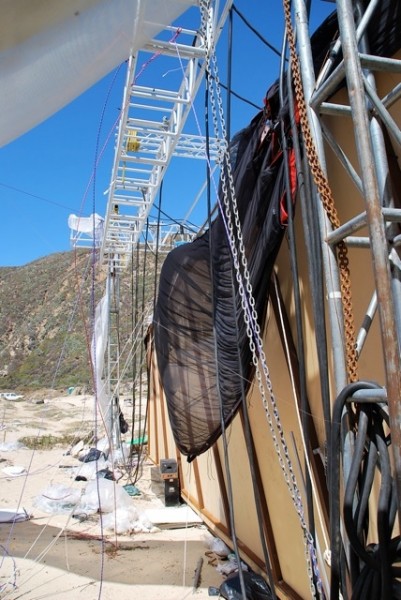
We were scheduled to be four days on the beach but needless to say shooting wasn’t easy with so many different production aspects to co-ordinate. Actresses’ start and end body positions were crucial for the editing process, the timing of sliding elements and green screen critical, the handling of the steadicam to keep the shots exactly as planned was vitally important, and warm and convincing performances essential.
Three out of four just wasn’t good enough and with a re-set of fifteen minutes or so between every take, time started to slip away. Then the generator started to play up and the switch-gear overheated so that the lighting couldn’t be fully utilised. A back-up ordered from Santiago - two hours away - was nervously anticipated as sparks tried to coax enough voltage through the system to keep the lights working, but it somehow managed to run off the road still half an hour away resulting in the loss of a morning’s shooting.
At the end of Friday 11th March we still had much to do on the beach and decided reluctantly that we needed to extend the location for another day. Unfortunately our hotel arrangements couldn’t be changed at such short notice and after a tiring afternoon and evening we all had to set off for the two-hour ride back to Santiago, arriving at midnight and knowing that we would have to be back up at 6am to make the trip back again. At least that’s what we thought would happen.
At 2.46pm JST on the afternoon of March 11th thousands of miles away off the coast of Japan an event was to occur that meant that that early morning trip back from Santiago to our location on the beach was cancelled. A huge earthquake created a tsunami that devastated the coast of Japan and triggered a huge wave travelling at 600kph across the Pacific. Devastating for the people of Japan and massively threatening for our production 5,000 miles away.
A huge earthquake created a tsunami that devastated the coast of Japan and triggered a huge wave travelling at 600kph across the Pacific. Devastating for the people of Japan and massively threatening for our production 5,000 miles away.
Instead of cramming ourselves into the minibus for the journey west we convened for a crisis meeting to decide what to do next. At this stage we didn’t really have the details and nobody seemed sure when the wave would arrive and how big it would be when it did. It was impossible for us to return to the location so the only thing we could do was to try to batten down the hatches on the set and make everything as safe as possible while removing as much as we could to higher ground.
We decided to keep everyone already in Santiago there, while some of the grips and construction crew who were based more locally in Valparaiso went down to the site and did as much as they could to make things safe. Then it was just a question of waiting to see what happened and alerting the insurers.
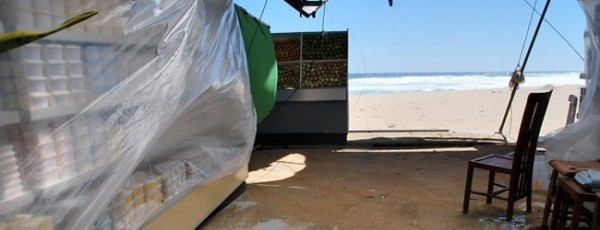
Although we had initially thought the wave would arrive at about 5pm, later calculations put the time at closer to midnight. We didn’t wait up but next morning we were desperate to know what had happened down at Valparaiso. The early reports seemed reassuring. The set was still there and in one piece, but more detailed examination provided a different story. The wave had been about a metre high when it reached the coast of Chile, had swept up the beach and lifted the entire set, twisting it and shearing vital components before setting it down again. The lighting rigs had fractured, the chiller cabinets twisted out of shape, sand had been swept right through the set and many of the flats were leaning at unlikely angles. It wasn’t safe or even possible to shoot.
More crisis meetings followed and it was decided that as we had to de-rig the entire set anyway, we would do that and bring it up to Santiago as we needed the same set in a different location to shoot the end scenes. We would then take the set back again to the beach to pick up the missing shots at the end of the schedule, in between times driving up to our Andes location up at 10,000 feet for the mountain shots. It was going to add a week to our stay in Chile but it seemed the only way to get all the material we needed.
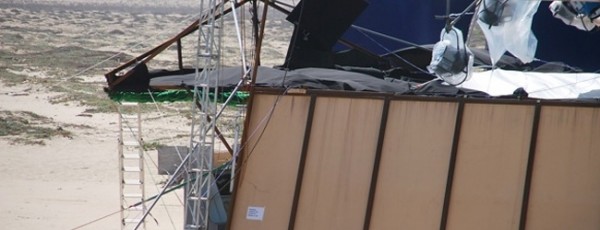
So everyone rallied round, new plans and schedules devised and the whole shoot re-organised. Luckily insurance was covering our costs but of course we had to act in the most economic and time-effective way to minimise the financial impact. But perhaps after all it wasn’t luck but being careful that allowed us to finish the job. Often insurance seems like an additional complication that one doesn’t need amongst all the myriad preparations for a complicated shoot. But I have never been so pleased that adequate insurance cover had been obtained by the production company. As the Agency Producer it certainly made for peace of mind to be able to reassure our clients that all the additional costs would be covered at no charge to them, and that we would somehow find a way to make up the lost time.
What had originally been a three-week stay in Chile became four weeks.
So what had originally been a three-week stay in Chile became four weeks. Additional hotel accommodation had to be found, crew and cast bookings extended, loved ones back in the UK and other countries alerted as to the problems - one poor actress was persuaded to cancel the hen party her friends had organised for her upcoming wedding. Shot by shot we got the footage we needed to complete the project.
The tsunami was a truly challenging event and one that couldn’t have been at all predicted, although of course the effects for other people were far worse than we encountered. I’m not sure if there is a moral hidden somewhere inside this tale but perhaps it might be that the old cliché of always to expect the unexpected might cover it.
And don’t forget to check your insurance.
Related Posts
- Filming in Chile with Raimundo Alemparte of Film Commission Chile
- How productions can navigate Chile’s early winter
- m ss ng p eces creates Urban-Knitter showcase in Santiago filming for 7Up Free
- While its industry improves Chile grows as a production service platform, hand in hand with Shoot in Chile
- Tiger Beer pulls a heist and doubles Santiago for the streets of New York City
- Natalie Dormer’s The Forest filmed on location in Serbia and Japan
- Filming in Chile with Location Manager Felix Hadad Rivas
- Chile attracts audiovisual productions from around the world
Related posts:
Comments
Not Logged in
You must be logged in to post a comment
There are no comments